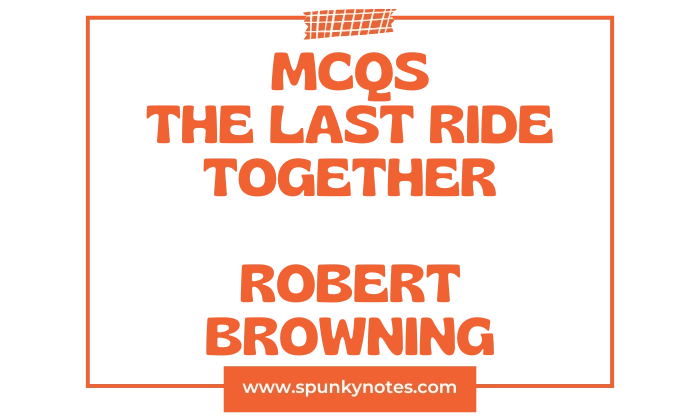
The Last Ride Together MCQs
1. Which literary age is “The Last Ride Together” most characteristic of, based on its author and stylistic elements?
A. Elizabethan
B. Modernist
C. Victorian
D. Romantic
2. In the opening stanza, what is the speaker’s initial emotional tone regarding his situation?
A. Deep despair
B. Bitter resentment
C. Naive optimism
D. Resignation and thankfulness.
3. What is the speaker’s attitude towards “fate” regarding his love?
A. He believes it can be changed through effort.
B. He accepts it as predetermined and unavoidable.
C. He is actively fighting against it.
D. He blames his mistress for his ill fate.
4. What specific request does the speaker make of his mistress after acknowledging the failure of his love?
A. To part ways immediately.
B. For “one more last ride” with her.
C. To return the hope she gave him.
D. To marry him despite the odds.
5. How does the mistress’s expression change as she considers the speaker’s request?
A. She smiles widely
B. Her pride yields to pity.
C. It remains impassive
D. She shows immediate anger
6. What is the immediate effect of the mistress’s intense gaze on the speaker?
A. It causes him to regret his request.
B. It makes him question his sanity.
C. It fills him with despair.
D. It replenishes his spirit.
7. What does the speaker imply about the gravity of the mistress’s decision by saying “With life or death in the balance”?
A. His life is in danger
B. His feelings depended on her
C. It was not important
D. She might kill him
8. Based on the imagery used, what time of day does the ride primarily take place?
A. It is progressing towards night.
B. Mid-afternoon.
C. Dawn or early morning.
D. The exact time is ambiguous.
9. What is the primary physical setting of the poem?
A. An open, outdoor landscape.
B. A room inside a dwelling.
C. An enclosed garden.
D. A dream world.
10. As the ride begins, how does the speaker describe the state of his soul?
A. It remains cramped.
B. It feels empty of emotion.
C. It becomes restless.
D. It becomes refreshed.
11. What poetic device and image does the speaker use to describe his soul smoothing out during the ride?
A. A blossoming flower.
B. A wild bird taking flight.
C. A long-cramped scroll unfolding.
D. A calm, still lake.
12. Once the ride commences, what philosophical question does the speaker dismiss as irrelevant?
A. What might have been had he acted differently in the past.
B. The meaning of life itself.
C. Whether he will ever find true love again.
D. Whether the world will end tonight.
13. What question does the speaker pose about general human success?
A. Is success truly desirable?
B. All men strive and who succeeds?
C. Who truly fails?
D. Who knows what success means?
14. The speaker contrasts his “riding” favorably with the perceived “unsuccess” of which general group of people?
A. People who choose solitary lives.
B. People who pursue wealth.
C. Those striving for public achievements.
D. Ordinary labourers.
15. How does the speaker contrast “the petty done” and “the undone vast”?
A. He sees them as equally important
B. He believes the done is always vast
C. Hé suggests the undone is insignificant
D. As a measure of human achievement versus unfulfilled potential
16. What is presented as a soldier’s “atonement”?
A. Financial reward
B. A medal of honor
C. The flag stuck on a heap of bones and a name scratched on Abbey-stones
D. Public praise
17. How does the speaker describe the poet’s skill?
A. Ability to earn money
B. Leadership qualities
C. Ability to express beauty
D. Physical strength
18. What does the speaker ask the poet about their personal well-being despite their artistic skill?
A. If they are Nearer one whit your own sublime
B. If they are well-respected
C. They enjoy their work
D. If they are physically strong
19. What does the sculptor’s “Venus” contrast with in the poem?
A. A painting
B. Another famous statue
C. The yonder girl that fords the burn
D. A piece of music
20. What does the speaker imply about the “man of music” and their legacy?
A. That their music will last forever
B. That their work is universally praised
C. Thát music is the most popular art form
D. That in music we know how fashions end!
21. What personal sacrifice does the speaker mention?
A. His time
B. Family
C. His youth
D. His wealth
22. What seems to be the speaker’s evolving view on traditional success or achievement as he rides?
A. He questions its ultimate value, finding his present experience superior.
B. He believes it is the only true measure of a worthwhile life.
C. He decides to pursue similar ambitions himself.
D. He is envious of others’ accomplishments.
23. What does the speaker explicitly state about “My riding” in contrast to the statesman and soldier?
A. It is more challenging
B. That is a waste of time
C. It is better
D. It is less important
24. What audacious thought crosses the speaker’s mind regarding the end of the world?
A. That he needs to prepare for the apocalypse
B. That he wishes the world would end tonight
C. Thát the world will continue as normal
D. That he should not think about such things
25. What scenario does the speaker imagine if “bliss” were proposed and he signed a bond for it?
A. He would still need to lead some life beyond
B. He would regret it immediately
C. Hé would share it with everyone
D. He would live happily ever after
26. What makes the speaker “sink back shuddering from the quest” for a fixed “glory-garland” or goal?
A. Fear of the unknown
B. His physical exhaustion
C. The mistress’s direct refusal
D. The implication that such a goal would end further seeking or living
27. The question “Earth being so good, would heaven seem best?” suggests the speaker’s:
A. Discontent with both earth and heaven
B. Belief that earth is a trial
C. Absolute preference for heaven
D. Contentment with his current earthly experience
28. What observation does the speaker make about his mistress’s communication during the ride?
A. She has been singing
B. She has not spoken so long!
C. She has spoken frequently
D. She has been giving directions
29. Towards the end of the poem, what ultimate possibility does the speaker contemplate regarding their ride?
A. That it will lead to the return of past love.
B. That it will soon end in tragedy.
C. Thát it might continue indefinitely.
D. That the world will forget it.
30. What is the speaker’s ultimate wish for heaven at the poem‘s conclusion?
A. That heaven proves that she and I ride forever
B. A static, unchanging paradise
C. A place of eternal rest
D. A return to their past life
Brief Overview
The Last Ride Together is a dramatic monologue poem by Robert Browning. The poem is narrated by a man who has just been rejected by the woman he loves. She is silent and severe, but he accepts her decision without argument.
The speaker makes one last, desperate request: he asks his former mistress for one final horseback ride together. To his great surprise and joy, she silently agrees to this final, shared moment.
As they ride, the speaker reflects on his failed ambition and his life. He begins to feel that this final ride is the high point of his entire existence. He contrasts the failure of human effort—in poetry, statesmanship, and war—with the perfection of the present moment.
The speaker decides that all earthly striving is futile. He concludes that even if he had achieved great fame, he would still be subject to failure and judgment. He believes that a single moment of perfect experience is worth more than a lifetime of imperfect achievement.
The poem ends with the speaker’s final, imaginative leap. He wonders if this perfect moment could be eternal.

